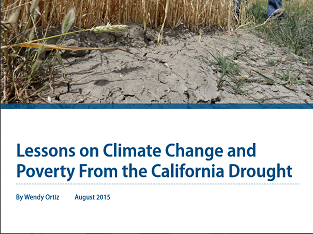As most of California endures near-record high temperatures this week, it seems like an appropriate time to discuss the intersection of the state’s historic drought, climate, and equity. A new report from Wendy Ortiz at the Center for American Progress, Lessons on Climate Change and Poverty from the California Drought, makes these connections and shows that low-income areas and communities of color are disproportionately impacted by the ongoing drought and climate change in general.
In her report, Ortiz summarizes the inequities faced by communities of color and low-income people and discovers that climate change serves as an escalating factor for these conditions:
The enduring effects of racial segregation and the underinvestment in low-income communities — in California and elsewhere — have placed people of color and low-income people in environments that threaten their physical and emotional health. Low-income communities and communities of color are most vulnerable to the effects of climate change due to poor-quality housing and infrastructure, proximity to environmental hazards, and economic instability. Because these communities have been institutionally excluded from accruing wealth and assets — which are prominent indicators of a family’s ability to prepare for unexpected shocks — they are less able to survive and recover from disastrous events.
The report also goes into detail about the drought’s impact on the state’s water supply and agriculture. As the water supply diminishes, it impacts California’s ability to produce the same amount of fruits and vegetables as it did before the drought. As a result, many retailers, particularly small grocers in rural and low-income urban areas, are finding it harder to stock fresh produce. The drought has also impacted the price of produce, which has risen in the past three years.
Ortiz also focuses on some specific communities and how they are impacted by the drought, in particular Native Americans:
Native Americans are another especially vulnerable community whose livelihoods are at risk of being disrupted because of the California drought. Droughts uniquely affect tribal nations because their native identities, ceremonies, practices, cultures, foods, medicines, and languages are often tied to a specific place and land. Many tribal communities, having already been systematically displaced from their native lands, lack access to water during nondrought years because of dams that divert their nearby water sources to other communities in California.
The entire report is worth a read as it paints a picture of the breadth of climate change’s socioeconomic impact. From the limited availability of produce to increased utilities bills, low-income populations and communities of color are particularly vulnerable to the drought and other consequences of climate change. It concludes with a number of recommendations to address the inequities caused by climate change, including reducing greenhouse gas emissions, improving water infrastructure, and involving community stakeholders.
At CPEHN, we have been spending the better part of the last year working to illustrate that climate change is a significant determinant of health. Our fall convenings last year and an accompanying fact sheet, A Forecast for Equity: Climate Change and Health in California, highlighted the issue and we plan to have a more robust report in the coming months. Exceedingly hot days like today remind us of the imperative of addressing our changing climate to achieve a healthier and more equitable future for our state.

